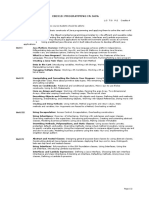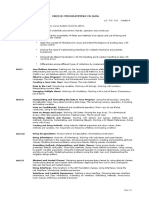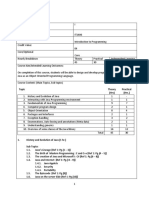0 ratings0% found this document useful (0 votes)
49 viewsJava Foundations
Java foundation
Uploaded by
sureshCopyright
© © All Rights Reserved
Available Formats
Download as PDF or read online on Scribd
0 ratings0% found this document useful (0 votes)
49 viewsJava Foundations
Java foundation
Uploaded by
sureshCopyright
© © All Rights Reserved
Available Formats
Download as PDF or read online on Scribd
You are on page 1/ 5
ORACLE academy oracle.com
Academy
Java Foundations — Course Objectives
Over
Ww
This course of study engagas students with itia programming eperiance. Students are ntrodtuoad to abject-oriantad once, 1s
torminology, and synta and the s.ops rayuired to create basic Java progiat's using !.ands-un, engaging actvitos. Students will learn
the concepts of Java programmning, design object orianted applications with Java and create Java programs using hands-on, engaging
activites,
Available C-rricuium Languages:
‘+ Arabic, Simpiied Shinese, English, French, Indonesian, Japanese, 3razlian Portuguese, Russian, Spanish
Duration
‘+ Racommandad tetal course time: 80 hours*
‘+ Frofessional education credit hours for educators who complete Sracle Acadamy training: 30
"Course ime inks mnsitucton, set studyo.-owork, practise, projacts ar. sss
“
‘Ya. get Audi
Euuca‘ors
‘* Technical, vocational, and 2- and 4-year college and universiy faculty members who teach computer programming,
information communications technology (ICT), or a related subject at a foundational level
‘+ Secondary and vocational school teachers who taach computor programming.
Students
'* Students who wish learn Java programming and build their Object Oriented Programming experience using Java.
‘+ This course isa suitable foundational ciass for computer science majors, and 'vhen taught in sequence with Java
Programming may be used to prepare students for the AP Computer Science A exam
Prerequi
Required
‘+ Oracle Academy Workshop - Getting Started with Java Using Alice
© Oracle Academy Workshop - Creating Java Programs with Greenfoot
Suggest=d
‘© Oracle Academy Course - Java Fundamentals
Suggested Next Courses
+ Oracle Academy Course - Java Programming
Copii 0202, Cras arr eis Alii rca Cac anna ahr ear of aan te Cohen ye Waar freephone
Lesson by-Lesson Topics and Objectives,
Section 4 — Introduction
+ +1 About the Course:
© Identify course goals and objectives
© Understand the course environment
© Describe the course learning strategy
* 1-2 ABriof History
(© Show examples of how paople interact with Java in their dally ives
© Summarize the history of Java
© Understand Java technology product groups
+ 1-3Setting up Java
‘© Understand the diference between the JK and JRE
© Understand the difference between java and .class fles
© Pesoribe the purpose of an integrated development environment (IDE)
© Download and install the JDK, JRE, and NetBeans IDE
(© Importa project into Netteans:
‘Section 2 ~ Java Soft ware Developme it
‘+ 2:1 The Software Davelopmant Procass
© Understand the Spiral Model of development
© Recognize tasks and subtasks of the Spiral Model
© Recognize what happens when stops are ignored
© Identify software features
© Understand how features are gradually implemented
‘+ 2:2Whatis my Program Doing?
‘© Understand how Java is read line by line
Set and use breakpoints
“End statements with semicolons (;)
Organize code using whitespace and other conventions.
© Create comments
‘+ 2.3 Introduction to Object-Oriented Programming Concepts
© Differentiate between procadural and object-oriented programming
© Understand a class as a blueprint for an abject
© Understand a class is used to create instances of an objact
© Model objects as a combination of
+ Proportios (data folds)
* Behaviors (methods)
Section 3 - Java Data Types
© 3:1 Whatis a Variable?
‘© Understand the benefits of variables,
© Identify four main types of variables:
= (Goolean, Int, double, String)
© Declare and assign values to variables
© Name variables according to conventions
+ 3:2.Numeric Data
Differontiatointoger data types (byte, short, int, long)
Differontiato floating point data types (float, double)
Manipulato and do math with numeric data
Use parentheses and order of operations
tual Data
Use the char data typo
Use Strings
oncatenate Strings
Understand escape sequences
Understand print statements better
2 33
eooceg co00
‘+ 3-4 Converting Between Data Types
Take advantage of automatic promotion
‘© And when to be cautious with promotions
Cast variables to other data types
1 And when to be cautious with casting
Parse Strings as numeric values
+ 35 Keyboard Input
Understand user input
Creato a JOptionPane to collect user input
Use a Scanner to collect input from the console
Use a Scanner to collect input from a fle
Understand how a Scanner handles tokens and delimiters
Section 4 — Java Meihods and Library Classes
* 4-1 Whatis a Method?
eoeg coccg coved coocccg vo0000
‘Structure code within a class
Instantiate an object
Understand the benefits of methods
Use the dot operator (,) to access an object's feds ard metheds
‘Supply arguments toa method
FRetum values from a method
import Doclaration and Packages
This losson cavers the following objectives:
‘Access a class by using its fully qualified name
Describe the function ofthe import statomant
Use the import statement to access a class in a package
Understand the purpose of an asterisk in an import statoment
Identify packages that are automatically imported
String Class.
Locate the String class in the Java API documentation
Understand the methods of the String class
Compare two String ebjects lexicographically
Find the location of a substring in a String object
Extract a substring from a String object
Random Class
Describe the purpose and uses of random numbers in Java programming
Identify mothads of the Random class that abtain random numbers
‘Obtain random numbers in a range of numbers
Uncarstand the purpose of the random number seed
Math Class
Understand the methods of the Math class
Use methods of the Math class to perform mathematical calculations
Use fields of the Math Class
Section 5 ~ Decision Statements
‘+ 5-1 Boolean =xpressions and else Constructs
© 62Ur
‘Declare, initialize, and use boolean variables
Compare boolean exprassions using relational operators
Greato an if statement
Great ifflsa constructs,
Compare Strings
Inderstanding Conditional Execution
Describe conditional execution
Describe logical operators
Understand “short circuit” evaluation of logical operators:
Build chained if constructs
5-3 switch Statement
‘© Create a switch control structure
© Compare ifelse constructs with switch control structures
© Understand the purpose of the break keyword
Section 6 ~ Loop Constructs
6-1 for Loops
‘© Understand the components of the standard for loop
© Understand how to create and use a for loop
© Understand variable scope
© Understand debugging techniques
Explain how infinite ops occur in Java
6-2.while and do-utile Loops
Use 2 while loop in @ Java program (pre-test)
Use a do-vhilo loop in a Java program (post-test)
‘© Understand when one loop type may be more beneficial than another
6-3 Using break and continue Stataments
>Use a break statement to exit a loop
(© Use a continue statement to skip par of a loop
Explain the need for leap comments
Section 7 — Creating Classes
7-4 Creating a Class?
© Create a Java testimain class
© Create a Java class in NetBeans
© Use conditionals in methods
© Translate specifications or a description into fields and behaviors
7-2 Instantiating Objects
‘© Understand the memory consequences of instantiating objects
© Understand abject references
© Understand the difference between stack and heap memory
© Understand how Strings are special objects
7-3 Constructors
© Understand default values
© Crash the program with a null reference
© Understand the default constructor
© Write @ constructor that accepts arguments
© Initialize fields with a constructor
(© Use this as an object reference
7-4 Overloading Methods
© Understand the effects of multiple constructors in a class
© Define overloading of a method
© Explain the method signature
© Understand whon overloading is and ist possibto
7-5 Object Interaction and Encapsulation
© Understand abject interaction in greater detail
© Use the private modifier to define class variables
© Understand the purpose of getter methods
© Understand the purpose of settar methods
7-6 static Variables and Methods
‘2 Describe a static variable and demonstrate is use within a program
© Describe a static methad and demonstrate Its use within a program
© Understand how to use the final keyword with static variablos
Section 8 ~ Arrays and Exceptions
© 8-1 One-dimensional Arrays
© Create and initialize one-dimensional arrays
© Modify an array element
© Traverse a one-dimensional array by using a for loop
© Identify the cause of an ArrayindaxQutOfBoundsException
© 8:2 ArayLists
© Groate an ArrayList
© Manipulate an ArrayList by using its methods
© Traverse an ArrayList using iterators and for-each loops
© Use wrapper classes and Autoboxing to add primitive data types to an ArrayList
‘+ &-9 Exception Handing
‘© Explain the purpose of exception handling
© Handle exceptions with atry/catch construct
© Daserite common exceptions thrown in Java
‘+ 84 Debugging Concepts and Techniques
© Testand debug a Java program
© enti the three types of errors
© Apply debugging tochnigues
+ print statements
+ NetBeans debugger
© Apply some debugging tips and techniques
Section 9 - JavaFX
'* 941 Introduction to Java FX
© Create a JavaFX project
© Explain the components of the default JavaFX project
© Describe different types of Nodes and Panes
© Explain the Scene Graph, Root Node, Scenes, and Stages
‘+ 9-2 Colors and Shapes
© Create and use custom colors
© Greate shapes and explain their properties and behaviors
© Reference the JavaFX Ensomblo
‘+ 9-3 Graphics, Audio and MouseEvents
© Create and use a JavaFX image and ImageView
© Greate and use JavaFX audio
© Create and use MousoEvents
© Understand Lambda expressions in GUI applications
To search and register for events scheduled in your area, visit the Academy events calendar
You might also like
- (Always Learning) Pandey, Hari Mohan - Java Programming-Dorling Kindersley (India) - Pearson (2012)100% (1)(Always Learning) Pandey, Hari Mohan - Java Programming-Dorling Kindersley (India) - Pearson (2012)889 pages
- Introduction To Programs and Java: Lund Amateur Coder's ClubNo ratings yetIntroduction To Programs and Java: Lund Amateur Coder's Club20 pages
- Syllabus:: Sr. No. Topics Fundamentals of Object-Oriented ProgrammingNo ratings yetSyllabus:: Sr. No. Topics Fundamentals of Object-Oriented Programming4 pages
- EBOOK Java Programming A Comprehensive Introduction First Edition Download Full Chapter PDF Kindle100% (56)EBOOK Java Programming A Comprehensive Introduction First Edition Download Full Chapter PDF Kindle61 pages
- Handout 2 Introduction To Java Programming LanguageNo ratings yetHandout 2 Introduction To Java Programming Language33 pages
- Cse229: Programming in Java: Through This Course Students Should Be Able ToNo ratings yetCse229: Programming in Java: Through This Course Students Should Be Able To2 pages
- Core Java Java Programming: Submitted By: Deepak KumarNo ratings yetCore Java Java Programming: Submitted By: Deepak Kumar32 pages
- PDF Reviewing Java Second Edition Alex Maureau downloadNo ratings yetPDF Reviewing Java Second Edition Alex Maureau download76 pages
- Pla1001 Programming-For-Computing-Engineers LT 1.0 7 Pla1001No ratings yetPla1001 Programming-For-Computing-Engineers LT 1.0 7 Pla10013 pages
- Practical 02 Periods Per Week (Each 60 Min) Tutorial - Hours Marks Theory 3 100 Practical 3 25 Oral - Term Work - 25 Evaluation SystemNo ratings yetPractical 02 Periods Per Week (Each 60 Min) Tutorial - Hours Marks Theory 3 100 Practical 3 25 Oral - Term Work - 25 Evaluation System4 pages
- Introduction To Core Java (At A Glance)No ratings yetIntroduction To Core Java (At A Glance)72 pages
- Amr Mohamed Abd Elhamid - JAVA - Day1,2,3,4100% (1)Amr Mohamed Abd Elhamid - JAVA - Day1,2,3,496 pages
- Intro To Java Programming For Object Oriented DevelopersNo ratings yetIntro To Java Programming For Object Oriented Developers8 pages
- CORE JAVA Syllabus: 1. Core Java Programming Introduction of JavaNo ratings yetCORE JAVA Syllabus: 1. Core Java Programming Introduction of Java9 pages
- (Always Learning) Pandey, Hari Mohan - Java Programming-Dorling Kindersley (India) - Pearson (2012)(Always Learning) Pandey, Hari Mohan - Java Programming-Dorling Kindersley (India) - Pearson (2012)
- Introduction To Programs and Java: Lund Amateur Coder's ClubIntroduction To Programs and Java: Lund Amateur Coder's Club
- Syllabus:: Sr. No. Topics Fundamentals of Object-Oriented ProgrammingSyllabus:: Sr. No. Topics Fundamentals of Object-Oriented Programming
- EBOOK Java Programming A Comprehensive Introduction First Edition Download Full Chapter PDF KindleEBOOK Java Programming A Comprehensive Introduction First Edition Download Full Chapter PDF Kindle
- Handout 2 Introduction To Java Programming LanguageHandout 2 Introduction To Java Programming Language
- Cse229: Programming in Java: Through This Course Students Should Be Able ToCse229: Programming in Java: Through This Course Students Should Be Able To
- Core Java Java Programming: Submitted By: Deepak KumarCore Java Java Programming: Submitted By: Deepak Kumar
- PDF Reviewing Java Second Edition Alex Maureau downloadPDF Reviewing Java Second Edition Alex Maureau download
- Pla1001 Programming-For-Computing-Engineers LT 1.0 7 Pla1001Pla1001 Programming-For-Computing-Engineers LT 1.0 7 Pla1001
- Practical 02 Periods Per Week (Each 60 Min) Tutorial - Hours Marks Theory 3 100 Practical 3 25 Oral - Term Work - 25 Evaluation SystemPractical 02 Periods Per Week (Each 60 Min) Tutorial - Hours Marks Theory 3 100 Practical 3 25 Oral - Term Work - 25 Evaluation System
- Intro To Java Programming For Object Oriented DevelopersIntro To Java Programming For Object Oriented Developers
- CORE JAVA Syllabus: 1. Core Java Programming Introduction of JavaCORE JAVA Syllabus: 1. Core Java Programming Introduction of Java


















































